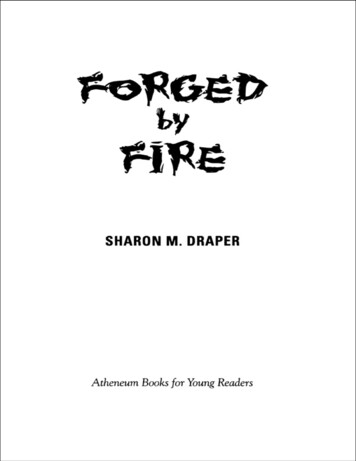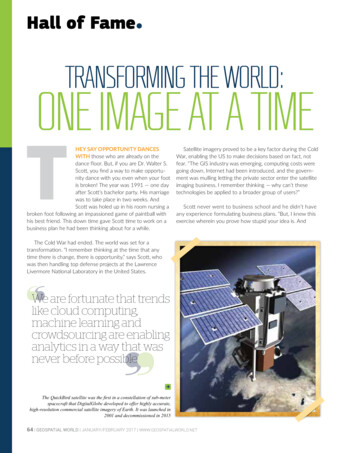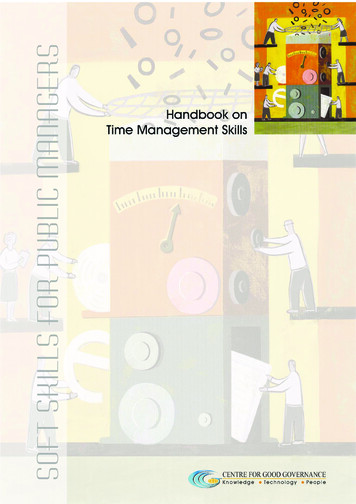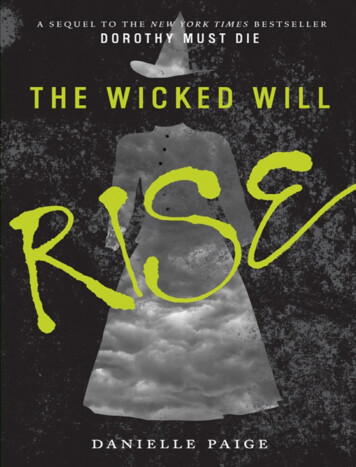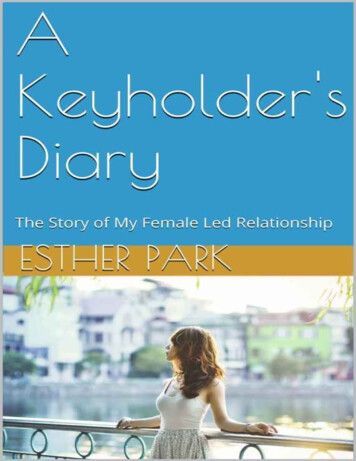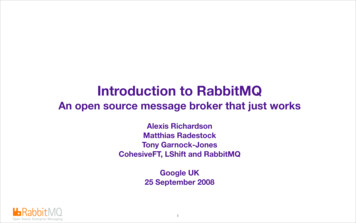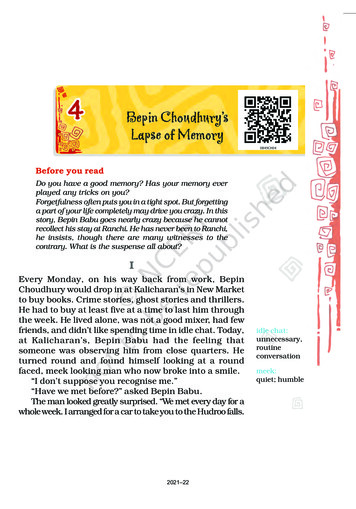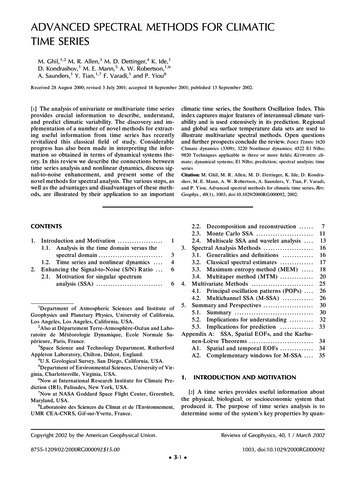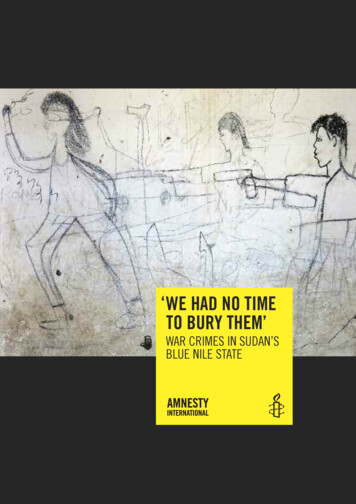
Transcription
‘ we had no timeto bury them’WAR CRImes In sudAn’sBlue nIle stAte
amnesty international is a global movement of more than 3 million supporters,members and activists in more than 150 countries and territories who campaignto end grave abuses of human rights.our vision is for every person to enjoy all the rights enshrined in the universaldeclaration of human rights and other international human rights standards.we are independent of any government, political ideology, economic interest orreligion and are funded mainly by our membership and public donations.First published in 2013 byamnesty international ltdPeter benenson house1 easton streetlondon wc1X 0dwunited Kingdom amnesty international 2013index: aFr 54/011/2013 englishoriginal language: englishPrinted by amnesty international,international secretariat, united Kingdomall rights reserved. this publication is copyright, but maybe reproduced by any method without fee for advocacy,campaigning and teaching purposes, but not for resale.the copyright holders request that all such use be registeredwith them for impact assessment purposes. For copying inany other circumstances, or for reuse in other publications,or for translation or adaptation, prior written permission mustbe obtained from the publishers, and a fee may be payable.to request permission, or for any other inquiries, pleasecontact copyright@amnesty.orgCover photo: a child’s drawing found in a bombed andabandoned school in blue nile state, sudan, april 2013. manychildren have been among those killed and injured in recentattacks by sudanese military forces on civilian villages in thestate. amnesty internationalamnesty.org
CONTENTS1. SUMMARY .7Key Recommendations .9Methodology .92. BACKGROUND .123. THE CIVILIAN TOLL.15Indiscriminate Bombing .15Deliberate Attacks on Villages in the Ingessana Hills .18Qabanit .21Jegu.23Khor Jidad .24Taga .27Indiscriminate Shelling .28Precarious Survival .29The Flight to South Sudan .324. DENIAL OF HUMANITARIAN ACCESS .355. ARBITRARY ARREST AND DETENTION .376. REFUGEE CAMPS IN SOUTH SUDAN.397. INTERNATIONAL RESPONSE .428. CONCLUSION AND RECOMMENDATIONS .43Recommendations .43Appendix: Satellite Imagery .48
Sudan and the ‘Two Areas’ (Southern Kordofan State and Blue Nile state).
Map of Blue Nile state, Sudan, and the refugee camps of Upper Nile State, South Sudan.
Sayub Ahmed Ule, age 67, walked for three days from the village of Wadega to reach the border of South Sudan. But several of hisfriends were too old and frail for the journey and were left behind.
‘We had no time to bury them’: War crimes in Sudan’s Blue Nile state71. SUMMARYWhen war broke out in Sudan’s Blue Nile state in September 2011, waves of refugeesnumbering in the tens of thousands poured out of the southern half of the state, fleeingindiscriminate aerial bombings and deliberate ground attacks by Sudanese military forces.Now, nearly two years later, some 150,000 people from Blue Nile state languish in a stringof refugee camps in neighboring Ethiopia and South Sudan, and tens of thousands more havebeen forcibly displaced within Sudan. And although the frequency of armed clashes betweenSudanese government and rebel forces has diminished, violence against civilians continues.“I lost my daughter last month when an Antonov bombed us,” a father who recently arrived ina refugee camp in South Sudan told Amnesty International in April, referring to the heavy,Russian-made transport planes that the Sudanese military uses to carry out its bombing runs.“When I heard the sound of the Antonov I yelled to my children to lie down on the ground. Itdropped a bomb, and I heard my wife cry out, ‘my child, my child, my child’. . . . She waseight years old.”Not just one but three children were killed in that attack, one of several 2013 attacks oncivilian areas in Blue Nile state that Amnesty International has documented. While theSudanese government says that it is fighting an armed rebellion by the Sudan People’sLiberation Army-North (SPLA-N), civilians in SPLA-N-held areas of the state are bearing thebrunt of the violence. In what appears to be a concerted attempt to clear the civilianpopulation out of SPLA-N-held areas, and to punish the residents of these areas for theirperceived support of the SLPA-N, the Sudanese government has both attacked civilians anddenied UN agencies and humanitarian groups access to assist them.Indiscriminate bombing has been the Sudanese government’s signature tactic in Blue Nilestate, to devastating effect. Bombs have injured and killed civilians, and damaged anddestroyed civilian infrastructure, including homes, schools, health clinics and farmland.Sudanese forces have also employed indiscriminate shelling, deliberate ground assaults oncivilian villages, and abusive proxy forces. These actions constitute war crimes—which, giventheir apparent widespread, as well as systematic, nature—may amount to crimes againsthumanity.The Ingessana Hills, the birthplace of rebel leader Malik Agar, have been particularly hardhit. During the first half of 2012, the Sudanese government carried out a deliberate scorchedearth campaign of shelling, bombing, and burning down civilian villages in the area, andforcibly displacing many thousands of people. Some civilians who were unable to escapewere burned alive in their homes; others were reportedly shot dead. The wide scale of theattacks was confirmed by satellite images obtained by Amnesty International, which showvillage after village in which nearly all of the homes were destroyed by fire, as were mosques,schools and other structures. Now, the only signs of life in these villages are Sudanesemilitary positions.Many civilians in SPLA-N-held areas of Blue Nile state abandoned their villages early on inthe conflict, and have spent many months living in makeshift, temporary shelters in the bush,Index: AFR 54/011/2013Amnesty International June 2013
8‘We had no time to bury them’: War crimes in Sudan’s Blue Nile stateoften moving from one temporary shelter to the next to escape bombing or shelling. Becauseof this forced displacement, vast areas of the state have been depopulated, and many villagesin SPLA-N-held areas in the south and west of Blue Nile state are either empty or sparselyinhabited.The humanitarian situation for people who remain in SPLA-N-held areas is dire. Unable totend their crops because of the fear of being bombed, many people—particularly those livingin remote parts of the state—face food shortages and other hardships. With the Sudanesegovernment barring humanitarian access to SPLA-N-held areas, food supplies are scarce;shelter is precarious, and even the most basic medical care is non-existent.These deprivations disproportionately affect the very old, the very young, and the disabled.Numerous refugees told Amnesty International about the plight of elderly and disabledpeople who—because they were physically unable to make the long trek to the refugee campsin South Sudan—were left behind. Some people were forced to choose between carrying theirchildren to safety or carrying their elderly parents. Others described how children died duringthe journey, victims of malnourishment, untreated diseases, and exhaustion.Sayub Ahmed Ule, age 67, was one of the lucky ones; he walked for three days from thevillage of Wadega to reach the border of South Sudan. But several of his friends were too oldand frail for the journey. “My friend Hussain is almost 80,” Ule said, describing a friend whowas left behind, “he can’t walk at all.”Amnesty International found that refugees from Blue Nile state face additional challengeseven upon reaching safety in South Sudan, including the threat of coercive recruitment bythe SPLA-N. The SPLA-N’s active presence within the camps undermines the camps’ civilianand humanitarian character, diverts scarce resources, and detracts from the credibility of thehumanitarian effort.Prospects for both refugees and people remaining in war-ravaged areas of Blue Nile state aredim. While the refugee outflow from Blue Nile state triggered a humanitarian response fromthe UN High Commissioner for Refugees (UNHCR) and aid organizations, the conflict hasotherwise received scant international attention. Preoccupied by relations between Sudanand South Sudan, the UN Security Council and the African Union have failed to take realaction to address the violent abuses, or to address the need for urgent and impartialhumanitarian assistance in Blue Nile state or in nearby Southern Kordofan state, where aclosely related armed conflict is taking place. The possibility of a long-term stalemate andprotracted forced displacement is extremely worrying.Much of what is now happening in Blue Nile state and Southern Kordofan follows a patternthat is familiar from Darfur, and, indeed, from Sudan’s decades-long war in southern Sudan,now South Sudan. Although Sudan’s President Omar al-Bashir and several other highgovernment officials remain under indictment by the International Criminal Court (ICC) forthe grave human rights crimes they allegedly committed in Darfur, the pursuit of justice haslagged. Neither the UN Security Council nor influential states have shown any greateagerness to press Sudan to cooperate with the court’s investigation, and President Bashircontinues to travel to an array of African, Asian and Middle Eastern countries withouthindrance. With no accountability for past crimes, there is little deterrence for those of theAmnesty International June 2013Index: AFR 54/011/2013
‘We had no time to bury them’: War crimes in Sudan’s Blue Nile state9present.KEY RECOMMENDATIONSTo the Government of Sudan: Immediately cease indiscriminate aerial bombings and deliberate ground attacks oncivilian areas; Grant immediate and unhindered access to UN agencies and internationalhumanitarian organizations to all areas of Blue Nile state, including via cross-borderaccess to SPLA-N-held areas from South Sudan, to facilitate the provision of allnecessary assistance to civilians affected by the conflict, including food, shelter andmedical care; Initiate prompt, effective and impartial investigations into violations of internationalhuman rights and humanitarian law and bring those suspected of criminal responsibilityto justice before ordinary civilian courts in fair trials, without the death penalty.To the UN Security Council and AU Peace and Security Council: Demand an immediate end to indiscriminate aerial bombings and other violations ofinternational humanitarian law by the Government of Sudan in Blue Nile and SouthernKordofan states; Urgently press the Government of Sudan to allow humanitarian organizations andindependent human rights monitors immediate and unhindered access to both Blue Nileand Southern Kordofan states; Establish an independent inquiry to investigate the serious violations of internationalhumanitarian and human rights law committed in the territory of Blue Nile and SouthernKordofan states since June 2011.METHODOLOGYThis report is based on interviews and other research conducted both inside and outsideSudan since the start of the conflict in Blue Nile state in 2011. Field research was carriedout in April 2013, during a 10-day visit to rebel-controlled areas of Blue Nile state, andrefugee camps in Upper Nile State, South Sudan. Amnesty International interviewed 42refugees and displaced people during this visit, including refugees living in three camps. Allof this report’s descriptions of indiscriminate bombings and deliberate attacks on the civilianpopulation are based on these interviews.Most interviews were conducted in Sudanese Arabic with English translation; in some casesinterviews were conducted in indigenous languages such as Ingessana, Uduk, and Jumjumwith English translation. While a few interviews were held in groups or in the presence offamily members, the majority were conducted in private.Amnesty International also interviewed numerous representatives of UN agencies and NGOsinvolved in the delivery of humanitarian aid to refugees in South Sudan, Sudanese rightsIndex: AFR 54/011/2013Amnesty International June 2013
10‘We had no time to bury them’: War crimes in Sudan’s Blue Nile stateactivists, community leaders, SPLM-N and SPLA-N officials, and academics. The names andaffiliations of some people have been withheld in order to protect them or their organizationsfrom possible reprisals. A thorough review of the relevant literature, including numerous pastreports on Sudan by Amnesty International, also informs our analysis.Amnesty International was unable to travel to government-controlled areas of Blue Nile statedue to the Sudanese government's long-standing denial of access to international humanrights organizations, and thus, with the exception of information received by phone, could notdocument human rights violations or other abuses that may be occurring in those areas.Amnesty International was also unable to document abuses committed by the SPLA-N,except for those in and around refugee camps in South Sudan.The satellite images used in this report were commissioned by Amnesty International fromDigitalGlobe Analytics.Amnesty International June 2013Index: AFR 54/011/2013
‘We had no time to bury them’: War crimes in Sudan’s Blue Nile state11Left: Child’s drawing in a partially bombed school in Somari,Blue Nile state.Below: Assit al-Bushra Idriss, age 50, faced hunger in thebush and survived on wild roots before finding refuge in theDoro refuge camp in South Sudan.Index: AFR 54/011/2013Amnesty International June 2013
12‘We had no time to bury them’: War crimes in Sudan’s Blue Nile state2. BACKGROUNDThe current violence in Blue Nile state is rooted in long-standing political and ethnicconflicts.1 During the second Sudanese civil war, from 1983 to 2005, Blue Nile was a keyfrontline state and the site of intense fighting between, on the one hand, Sudanesegovernment forces and their proxy militias, and on the other, the southern-dominated SudanPeople’s Liberation Army (SPLA).2 Areas of southern Blue Nile around Yabus and Kurmukwere held by the SPLA at several points in the conflict, leading to heavy governmentreprisals.3 Facing indiscriminate bombings and other abuses, tens of thousands of civiliansfled to Ethiopia, some remaining there for years.4During the peace negotiations that finally ended the civil war, the ruling National CongressParty (NCP) opposed granting self determination to Blue Nile and Southern Kordofan, twostates that were located north of the presumptive border with southern Sudan but that hadstrong popular support for the Sudan People’s Liberation Movement (SPLM). The SPLM,focused primarily on securing a self-determination referendum for the south, did not prioritizethe status of Southern Kordofan and Blue Nile, settling on a vaguely-worded compromisesolution that promised “popular consultations” in the two states. In the 2005 ComprehensivePeace Agreement, therefore, the future of the two states was left uncertain.In January 2011, southerners voted overwhelmingly for independence. As the secession ofSouth Sudan loomed, tensions rose over the status of the thousands of SPLA soldiers stilldeployed north of the planned border between the two countries. Khartoum refused tointegrate them into the government forces, and in May 2011 demanded that all SPLA troopsnorth of the border be withdrawn to the south.Attempts by Sudanese security forces to disarm the SPLA in Southern Kordofan state quicklyescalated, engulfing the state in full-scale conflict in early June 2011. On 1 September, twomonths after South Sudan became formally independent, fighting spread to Blue Nile state.Sudanese government forces bombed the residence of Malik Agar, the leader of the SPLM-Nin Blue Nile and state governor. In the following days, President Bashir removed Agar asgovernor, banned the SPLM-N, and declared a state of emergency in Blue Nile.Vastly outnumbered by government forces, the SPLA-N lost Damazin, the state capital, in amatter of days. In the following two months, the government asserted its authority over largeswathes of territory south of Damazin. On 2 November 2011, it took over Kurmuk, thesouthernmost urban centre in the state and a key SPLA-N stronghold.Most of the refugee outflow occurred during the first six months of the conflict.By March 2012, more than 100,000 people had fled Blue Nile state for Ethiopia and SouthSudan, and tens of thousands more were believed to be displaced within the state. Since thattime there have been occasional surges of violence and a smaller but continuing outflow ofcivilians to South Sudan, raising the current count of refugees to about 150,000.5New fighting erupted in late 2012 and continued in early 2013 along the front lines,Amnesty International June 2013Index: AFR 54/011/2013
‘We had no time to bury them’: War crimes in Sudan’s Blue Nile state13particularly in and around the villages of Ulu, Baldugu, Surkum, Mayak and Mufu.6 It wascharacterized by indiscriminate aerial bombardment and shelling, causing furtherdisplacement.The SPLA-N now controls the southernmost part of Blue Nile, as well as certain parts of thewest, areas that are south and west of a zigzagging line running from Ulu to Surkum, Mufu,and Diem Mansour. The de facto division of the state has historical precedents. During the1990s, when the SPLA controlled territory in Blue Nile state, the state functioned as twoadministrative units: its northern areas—including Damazin, Bau, and Roseres localities—were under the control of the Sudanese government, and its southern reaches, includingKurmuk, were run by the SPLA.7 Many of the ethnic groups in the latter areas have deephistorical ties to the SPLA and a long-standing mistrust of Khartoum.It is difficult to estimate the pre-war population of areas currently controlled by the SPLA-N,but Sudan’s 2008 census gives a rough sense of their numbers. Out of a total Blue Nilepopulation of 832,112, about 111,000 lived in Kurmuk locality, in the south of the state,and another 127,000 lived in Bau locality, in the centre and west of the state.8 Of Blue Nilestate’s six administrative districts, Kurmuk and Bau are the only two in which the SPLA-Ncontrols territory, and they are where the civilian population has been hardest hit. Many partsof Bau locality, in particular, have been emptied out, with civilians fleeing to Kurmuklocality, to refugee camps outside the country, or to government-controlled areas of Blue Nilestate.9Precise estimates of how many people remain in rebel-controlled territories of Blue Nile statedo not exist, but they are believed to number in the tens of thousands.10Prospects for a prompt resolution to the conflict seem remote. An agreement reached in June2011 following negotiations between the SPLM-N and the government, was quicklyrepudiated by President Bashir, and efforts to agree to a ceasefire since then have all failed.The two parties resumed direct negotiations in April 2013, but no visible signs of progresshave been made.Index: AFR 54/011/2013Amnesty International June 2013
14‘We had no time to bury them’: War crimes in Sudan’s Blue Nile stateYusuf Fadil Muhammed lost his eight-year-old daughter Dahia in February 2013 when an Antonov dropped bombs on Benamayo,where they had found refuge. Dahia’s head was injured and she bled heavily. Yusuf carried her for two hours to seek medical help,but she died on the way.Amnesty International June 2013Index: AFR 54/011/2013
‘We had no time to bury them’: War crimes in Sudan’s Blue Nile state153. THE CIVILIAN TOLLSince the onset of the armed conflict in Blue Nile state in September 2011, the Sudanesegovernment has carried out frequent indiscriminate aerial bombing of SPLA-N-held areas ofthe state, as well as deliberate ground attacks against civilian villages and indiscriminateshelling of civilian areas close to the front lines. Residents of areas held by the SPLA-Ninterviewed by Amnesty International—who are often from ethnic groups such as the Uduk,the Ingessana and the Jumjum that are perceived as supporting the insurgency—facekillings, serious injury and forced displacement.INDISCRIMINATE BOMBINGThe Sudanese government’s signature tactic in Blue Nile state, as in other armed conflictspast and present, is indiscriminate aerial bombardment.11 Nearly every single refugee anddisplaced person interviewed by Amnesty International cited bombing as a primary factor—often the single most important factor—motivating their decision to abandon their home andseek refuge elsewhere. Scores of civilians have been killed and injured in bombing attacks;homes have been destroyed; schools and other civilian facilities have been severely damaged,and livestock have been slaughtered. The frequent overflights, even when the planes are notdropping bombs, stoke civilian fear.In carrying out bombing runs, Sudanese forces generally fly heavy Antonov cargo planes athigh altitudes, and use unguided bombs that cannot be precisely targeted.12 When conductedin areas inhabited by civilians, such attacks are inherently indiscriminate, and thus inviolation of international humanitarian law.Additionally, in all of the bombing incidents that Amnesty International investigated,witnesses and victims stated that there were no SPLA-N troops or other military targets in thevicinity at the time of the attacks. While Amnesty International cannot confirm, in every case,that SPLA-N forces were absent, the uniformity of the civilian accounts—and the civilians’unqualified belief that they were the targets of the Sudanese government’s attacks—wasstriking. Civilians often spoke of hiding from military planes and told Amnesty Internationalthey believed that if they were spotted they would be bombed.Amnesty International documented several fatal bombing attacks that occurred in 2013. Anattack on 26 February near the village of Benamayo, in Kurmuk locality, killed three children,including Dahia Yusuf Muhammed, age eight.When I heard the sound of the Antonov I yelled to my children to lie down on the ground,”said Yusuf Fadil Muhammed, Dahia’s father. “[The Antonov] dropped a bomb, and I heardmy wife cry out, ‘my child, my child, my child.’ The plane circled back and dropped two morebombs, and my neighbors yelled at me to get back down on the ground, to protect myselffrom the bombing. I said to them, ‘I can’t stay down; my child is dying.’Dahia was still alive when her father reached her. She had been hit in the head and hand byshrapnel and was bleeding heavily. Her father carried her for two hours in a futile effort toreach the border area and obtain medical care; she died along the way.Index: AFR 54/011/2013Amnesty International June 2013
16‘We had no time to bury them’: War crimes in Sudan’s Blue Nile stateDahia’s cousin Umana Muhammed, age four, was killed by the same bomb; the girls hadbeen playing together when the attack took place. Hit in multiple places by shrapnel, she waskilled instantly, her relatives told Amnesty International.Both Yusuf Fadil Mohammed, Dahia’s father, and Assor Muhammed, Umana’s father,originally from Mufu, had only been in the Benamayo area for a few days when the attackoccurred. They told Amnesty International they had moved there out of fear, because offrequent Antonov overflights in their previous location. After the deaths of the two girls, bothfamilies fled immediately to South Sudan.The third child who was killed in the Benamayo bombing was Sobri Abdulahi, age five. BatulGambi Buldogi, the boy’s mother, was resting under a tree with her four children when theattack took place. “It was about 4 pm,” she said, “my husband had gone to get water. I washolding my new baby, and the other children were playing near me. The Antonov bombed us,injuring me and two of my children.”His parents said that Sobri Abdulahi was not killed instantly, but was badly injured in the legand the stomach, with some of his intestines exposed. His father tried to carry him to theborder to obtain medical care, but he died before they arrived there. Dictor Abdulahi, anotherson, age seven, lost his toe in the attack and was operated on at Bunj Hospital in SouthSudan to remove shrapnel from his back. Buldogi, the mother, was injured in her left leg.Originally from the Mufu area, the family told Amnesty International they were on their way toSouth Sudan and were only resting in Benamayo when the attack occurred.A similar attack reportedly took place in March 2013 near the village of Balila, in Kurmuklocality. Two young children were killed: a boy named Abdallah Imam, age three or four, anda girl named Aisha Muhammed, age approximately seven.13“We were taking shelter in the bush near Balila,” recalled Bushra Imam, a sheikh (traditionalleader) from Balila. “When the Antonov came, at about 1pm, I hid. Afterwards we lookedaround and found their bodies. The girl had been hit in the left side; the boy’s body wastotally destroyed.”Maki Bala, a sheikh from Lebu village, near Wadega, described a recent attack that he saidtook place on 10 April 2013. He told Amnesty International that a group of people werewalking together not far from Lebu; they had gone to get water. An Antonov reportedlydropped three bombs in succession, killing a young man named Farajallah and a teenage girlnamed Fatima. “We buried them,” Bala said. “Farajallah was cut in two.”The Ingessana Hills, southwest of the state capital, Damazin, were subject to frequentindiscriminate bombing during the first half of 2012. In an incident in May 2012, an elderlyman named Adam Abu Shok was reportedly killed in his home in the village of Jegu. Ali Ablil,an acting sheikh from Jegu, described what happened:Adam was still living in his home, which was in a group of four houses, a bit outside thevillage. I was hiding in the bush about 300m from there. Adam was inside his home whenthe Antonov came and dropped two bombs. One fell near the water. The other fell nearAmnesty International June 2013Index: AFR 54/011/2013
‘We had no time to bury them’: War crimes in Sudan’s Blue Nile state17Adam’s home and flattened it. I got afraid for my children and ran to the water place to see ifthey were safe. Then I ran to Adam’s house and found him dead. Shrapnel had hit him in hisstomach and armpit.Near neighbouring Khor Jidad, an elderly man was killed in August 2012. Balla al-BehQasim, a 39-year-old man from the village of Tordabugul, told Amnesty International:We were in the bush near Khor Jidad. At night we would leave our shelters to get food, but wecouldn’t do it during the day because of Antonovs. There was this man from Agadi who wasstaying with us. I can’t remember his name—he was about 50 years old. One day in August2012 he went to get food in the morning with his donkey. He was on the road when he washit by an Antonov. We went there in the evening to see what had happened. We found hishead cut off and his legs cut off. His stomach was open and his hand was severed. Dogs wereeating his corpse.INTERNATIONAL LAW AND ATTACKS ON CIVILIANSSudan is under a legal obligation to respect the right to life of everyone within its territory andsubject to its jurisdiction, a right that is non-derogable under the International Covenant on Civil andPolitical Rights and that is also protected under the African Charter on Human and Peoples' Rights.14Sudan is a state party to both these treaties.International humanitarian law (IHL), which applies only in situations of armed conflict, regulates the conductof hostilities. Its central purpose is to limit, to the extent feasible, human suffering in times of armed conflict.Since September 2011, when the non-international armed conflict in Blue Nile state began, all parties to theconflict have been bound by the applicable rules of IHL.15 Serious violations of these rules may amount to warcrimes.A fundamental rule of international humanitarian law, known as the principle of distinction, requires partiesto the conflict to at all times “distinguish between civilians and combatants.” In particular, “attacks
in South Sudan—were left behind. Some people were forced to choose between carrying their children to safety or carrying their elderly parents. Others described how children died during the journey, victims of malnourishment, untreated diseases, and exhaustion. Sayub Ahmed Ule, age 67, was one of the lucky ones; he walked for three days from the
